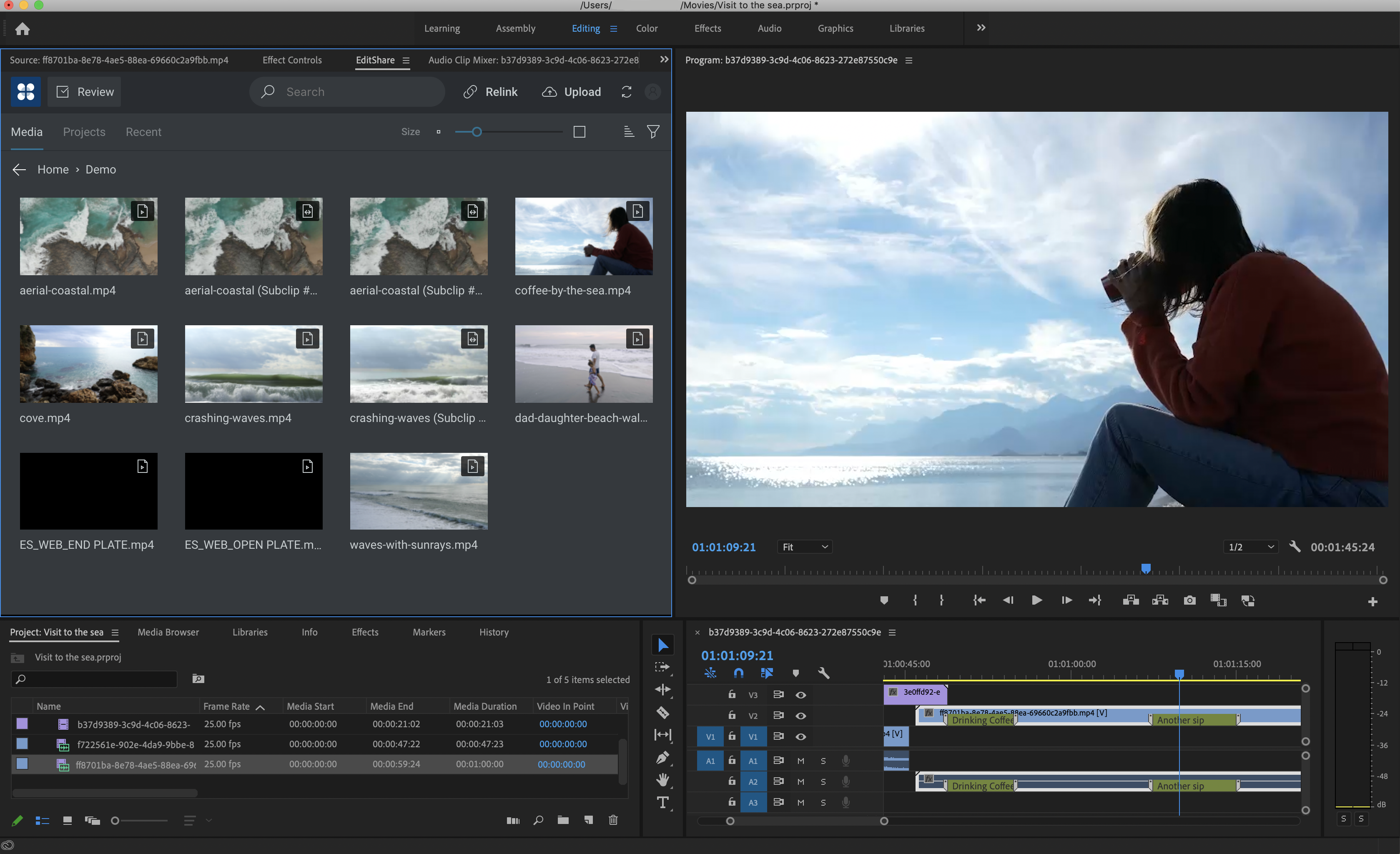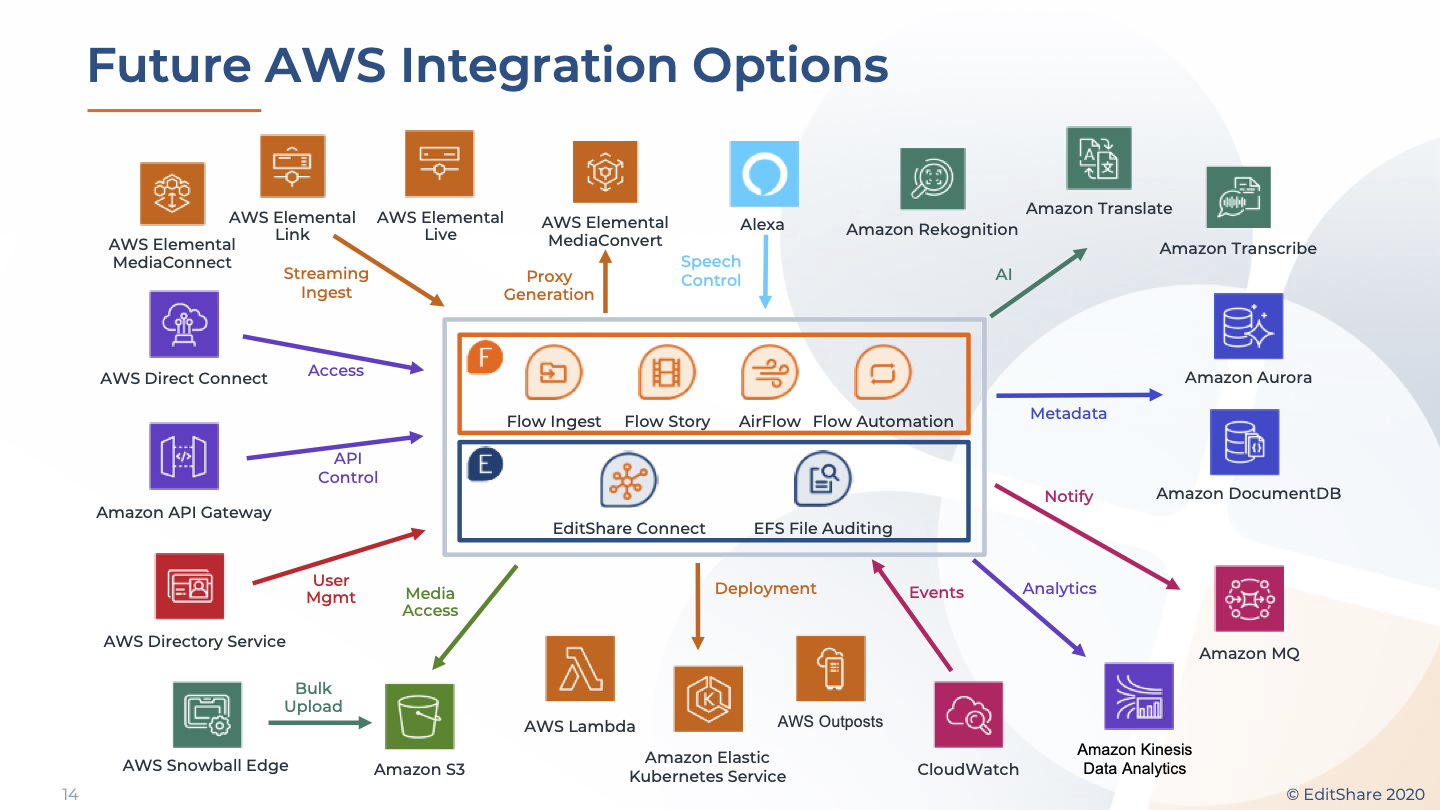AWS for M&E Blog
A solution for collaborative, scalable, and adaptable content editing on AWS
This post is authored by Tom Rosenstein, VP Business Development, EditShare. The content and opinions in this post are those of the third-party author and AWS is not responsible for the content or accuracy of this post.
 The migration to video production workflows to the cloud continues to accelerate. The demand for content creators to work from anywhere while maintaining a collaborative office-like manner is more prevalent than ever. AWS and EditShare are working together to build cloud-hosted solutions to address these customer requests. Video production has long required expensive on-premises hardware, dedicated networks, and an agile IT effort to meet the ever-changing requirements of content creation. The economics and other benefits of the cloud, however, are allowing these workflows to begin this migration to an elastic and agile environment. Facilities that migrate to the cloud are in the envious position of scaling up or down at a moment’s notice. They are also able to adapt to ever-changing market conditions and demands.
The migration to video production workflows to the cloud continues to accelerate. The demand for content creators to work from anywhere while maintaining a collaborative office-like manner is more prevalent than ever. AWS and EditShare are working together to build cloud-hosted solutions to address these customer requests. Video production has long required expensive on-premises hardware, dedicated networks, and an agile IT effort to meet the ever-changing requirements of content creation. The economics and other benefits of the cloud, however, are allowing these workflows to begin this migration to an elastic and agile environment. Facilities that migrate to the cloud are in the envious position of scaling up or down at a moment’s notice. They are also able to adapt to ever-changing market conditions and demands.
AWS has supported EditShare’s strategic embrace and migration of core video production services to the cloud. This led to the availability of EditShare’s EFSv shared storage platform and FLOW media management solution. This solution on AWS offers significant new benefits to traditional video workflows. It replicates the traditional working environments video editors demand, with the flexibility and OpEx-oriented solution that businesses now require. Those benefits include:
- Meeting the needs to scale from small to large workgroups and back again
- Scalable storage solutions for workgroups and enterprises, from terabytes to petabytes
- Adaptability to a variety of workflows and fast integrations via an API-first approach to any number of AWS AI/ML services

The Elements of EFSv Video Production
Cloud-based video production requires five key elements to meet baseline requirements.
- A scalable and secure managed shared storage environment. EFSv is based on EditShare’s award winning clustered file system optimized for video production. Designed with editors in mind, EFSv provides the collaborative, high-speed storage platform workgroups demanded to meet their high-quality production goals. These capabilities include a single global namespace, user management controls, project security, and final auditing. EFSv extends this capability across any non-linear-editor (NLE) and across Windows, macOS, and Linux platforms.Reengineered for an AWS environment, EFSv can scale up or down, adding storage and removing various AWS elements to meet the needs of production workloads. Editor-focused management tools allow storage to be segmented based on a project or workgroup. This provides the ability to flexibly carve up resources based on individuals or workgroup needs.
- A media asset management platform that exceeds production needs. EditShare’s FLOW provides the services to ingest, index, manage, automate, and share video assets across workgroups in an intelligent and controlled environment. Designed specifically for production workgroups, FLOW assists editors by creating proxy revisions of all content, including a timeline editor for story compiling and AirFLOW, a review and approvals tool.
- EditShare’s EFVs video-editing workstations. EditShare provides pre-configured Amazon Machine Images (AMI) optimized to support NLE applications and provide connectivity to the EFSv storage and FLOW media management. These EditShare AMIs are based on the AWS Cloud Editing templates and are pre-configured with additional software to support virtualized editing. This software includes EditShare Connect software for connectivity to EFSv, FLOW Story for rough cut editing and connectivity to the asset manager, and Teradici software for remote desktop connectivity. EditShare supports a Bring Your Own License (BYOL) model, allowing content producers to use their existing content creation tools and licenses, such as Adobe Premiere Pro. AMIs are available for both Windows and Linux environments.
Since virtualized cloud editing stations require connectivity to remote users, EditShare recommends Teradici Cloud Plus remote desktop sharing to allow responsive connectivity of the NLE display and controls. The result is local-like performance from a remote NLE.
These AMIs are virtualized in AWS and all services can be scaled to meet the on-demand production needs of customers. The virtualized workstations provide the horsepower desired by clients, enabling them to improve performance at a moment’s notice. Furthermore, with EditShare’s Seamless Proxy Editing technology, clients can use virtualized workstations to work on both block and object storage concurrently.
FLOW provides browser and client-based applications to allow non-editors access to the content library for purposes such as browsing libraries, setting up workflows, review and approval applications and more. Next, I dive deeper into these components, what they do, and their benefits to customers.
How it is architected
The following diagram provides a high-level overview of the EditShare EFSv architecture:

EFSv
EFSv supports a single-node, all-in-one deployment where all video storage and FLOW media management services can be deployed on a single EC2 instance with attached Amazon Elastic Block Store, or with a cluster of like-systems to provide additional storage as well as for bandwidth editing requirements. For those clustered systems, EditShare deploys an N+1 cluster that can reside across multiple AWS Availability Zones (AZ) to ensure higher availability. See the diagram below for an example of a simple, 3-node cluster.

Solution Overview of EFSv and FLOW in AWS
Working together with AWS, we characterized and benchmarked various workloads across a number of EC2-type instances. We settled on the R5n and C5n series, which provide the required networking bandwidth for editing workstations. Specific selection of the Amazon Elastic Compute Cloud instances is based on customers’ needs and the availability of each instance within the requested data center. Taking advantage of AWS worldwide footprint, EditShare can deploy in any AWS data center to minimize any possible network latency issues for users operating cloud-based editors.
EFSv leverages Amazon EBS to provide the responsiveness that creatives enjoy in an on-premises environment. EBS is attached locally to an EC2 instance and can scale to support the full storage requirements of any workgroup or enterprise.
While AWS also offers other storage tiers, from locally attached storage to Amazon FSx for Lustre, each of these tiers addresses some component of high-speed accessibility but with different cost points and features. EditShare evaluated each solution for the specific application of video editing and production and found that EFSv provided a richer feature set at a far more economical price point. We continue to review new services for storage and compute instances and adopt those that provide the most benefit to our customers.
FLOW
EditShare FLOW provides video production media management. This lightweight, skinny MAM is focused on providing a video workflow environment with powerful core functionality and broad NLE compatibility that is right-sized out of the box to achieve easy implementation and instant efficiency. Through its set of open APIs, FLOW can also be tailored to customer needs, enabling effortless collaboration with other tools or systems.
FLOW can operate as a co-resident application on the single node, all-in-one EFSv for many workflows. Additionally, adapting to unique workflows for high volume proxy generation and library sizes is simple given the fact that AWS provides the vertical scaling it supports via its range of R5n and C5n EC2 instances.
Optimizing for storage and cost effectiveness
EditShare is a customer-centric company, constantly listening to clients’ needs and requirements. One of the most common requests has been to develop a solution that lowers total cost of ownership (TCO) while offering time-saving features. EditShare’s Seamless Proxy Editing feature is our most recent example of innovation in this area.
As content creators begin migrating their video editing to the cloud, they can run into challenges with cost. To meet the application requirements of video editing, block-based storage is required. NLEs require this for both performance reasons and because it provides the file-system requirements applications expect to operate properly. Storing large content libraries within block-storage is not cost effective for all enterprises, and consequently many production teams lean towards on-premises solutions.
EditShare’s Seamless Proxy Editing feature solves this issue and can lower the cloud infrastructure costs of editing up to 70%. The magic behind this solution was developed as a result of EditShare’s participation in an AWS Hackathon earlier this year.
To begin with a bit of background, proxy-based editing has long been used in the video editing world as a cost-effective solution for editing large media files. As high-resolution video files can easily exceed 100 Mb/s or even over 1 Gb/s, taking up TBs of storage, only the most high-performance workstations were able to keep up with the workload necessary to work with multiple video and audio tracks. The industry solved this issue by creating lower resolution, frame accurate proxies of the original content that can be edited on mainstream editing systems. Final ‘finishing’ would then occur on dedicated workstations using the ‘Edit Decision Lists’ created during the proxy editing stage. This workflow was economical but problematic due to cumbersome processes. Every editor knows finishing, also known as conforming, is always fraught with unforeseen issues. EditShare addresses these challenges with an innovative, cost effective solution.

EFSv solves these issues by putting high resolution files into cost-effective object storage but makes those files appear as if they are on a normal mounted block storage file system. FLOW creates proxies, stores them on a much smaller EBS volume, and makes them instantly accessible by the NLE. As an extension of FLOW, a panel within the NLE “teaches” the application about the existence and location of both high resolution and proxy versions. Editors can toggle back and forth between versions at any time. They can then edit in proxy but are always able to view the high-resolution content as well. Selecting the render button then allows the editor to view the final project, requiring no copying and no unwieldy workflow steps. The result: no mistakes. FLOW even allows these workflows to occur on a home or office resident NLE over a VPN. The outcome is a truly simple, cost-effective workflow that can adapt to any work environment.

In addition to this intelligent use of AWS storage tiers, customers benefit from the economics AWS provides through its various EC2 instances used for editing. AWS recommends the g4dn family of workstations, which include NVIDIA GPUs and scale to support the various needs of editing requirements. EditShare’s video editing AMIs allow customers to choose the EC2 instances that provide money-saving outcomes for their use cases.
Where is it all going?
EditShare continues to work with AWS to integrate and employ the rich set of services customers require for scaling their video productions. For example, many of the services cataloged in the following diagram are already available to extend the capabilities available to video production companies. For example:
- AWS Media Services: Allows for the scaling of encoding services, as well as video distribution and delivery
- AI/ML Services: Allows for intelligent metadata creation, including transcription, and video/image detection.

The EditShare FLOW system, built using an API-first mentality, allows for the integration of these services, providing customers with the infrastructure to assemble end-to-end workflows using any combination of building blocks.
EditShare and AWS continue to evolve cloud-based video production. Innovations in services, end-to-end workflows, cost management, and ease of use ensures the future success of customers, enhancing media management and workflow processes for creative storytellers.